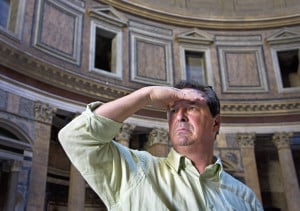Forty-five new color photographs by Joel Leivick grace the walls of Stanford’s Thomas Welton Art Gallery as part of his new exhibit, “The Rapture.” This engaging and thought-provoking collection features a variety of candid portraits of visitors at one of Rome’s most famous tourist locations, The Pantheon.

Leivick, the Robert and Ruth Halperin professor in photography, has been with the Department of Art & Art History at Stanford since 1981. He has also participated in a variety of solo and group shows in the Bay Area, including at the San Francisco Museum of Modern Art, the Scott Nichols Gallery (also located in San Francisco) and the Santa Cruz Museum of Art and History. His work has also been exhibited in several out-of-state galleries, such as the Blue Sky Gallery in Portland, Ore., and the Emory University Art Gallery.
Leivick’s new exhibition is a departure both visually and conceptually from his previous work. Before “The Rapture,” he worked in large-format black and white landscapes and outdoor scenes, all very rich in texture; yet, what interested Leivick the most at the Pantheon were the visitors all around him. Over the course of four days last fall, he took a series of candid photos using a Sony digital camera.
While simpler in both texture and composition than his previous work, the beautifully lit and color-saturated photographs of “The Rapture” present an interesting contrast between old and new: the visitors, armed with their cameras, cell phones and iPods, against the building’s ancient stone walls.
Though Leivick lays no claims that, through his photographs, he has come to “know” any of these people, the images evoke a certain intimacy — a connection between viewer and subject that makes you want to keep looking — that makes you feel like you could know these people, too. The subjects of Leivick’s photos come from all walks of life — men, women, adults and children alike — but the looks of concentration and awe spread across each face create a peculiar feeling of commonality.
As I walked through the gallery looking at the photographs on the walls, I couldn’t help but notice the same expressions of the photo subjects reflected in the faces of everyone at the exhibit’s reception. Leivick’s photos remind us that, as humans, we all strive to find meaning in beauty. Just as the Pantheon visitors screw up their faces in concentration as they gaze through the oculus in search of some profound experience, so do we at Leivik’s photos of them.
